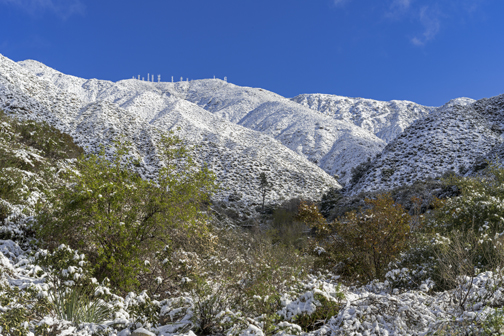
The rain, rain, rain came down, down, down in a rushing, rising riv’lets. ’Til the river crept out of its bed, And crept right into Piglet’s. – “Rain, Rain, Rain Came Down, Down, Down” from “Winnie the Pooh and the Blustery Day”
By Mary O’KEEFE
It has been raining a lot and snowing in the mountains and in lower elevations. We have seen rainfall totals of more than eight inches in one storm. The hillsides that were brown this time last year are now green and reservoirs that were almost empty are now close to full capacity … and more rain is expected. But the rainfall, though welcome, has brought mudslides and the snow in the mountains has trapped many Californians. Gov. Gavin Newsom activated the California National Guard in 13 counties due to the winter storms.
With all of this, does that mean that our drought is finally over? Well, yes, most of the state has moved from extreme and/or exceptional drought to moderate-to-abnormally dry.
Every Thursday scientists from the National Oceanic Administration Agency (NOAA), U.S. Dept. of Agriculture and Drought Mitigation Center produce maps that show what parts of the country are dealing with drought. They share this information on drought.gov.
As of last Thursday, 83.3% of California is considered abnormally dry –meaning the soil is dry, irrigation delivery begins early, dry-land crop germination is stunted and active fire season begins.
The three-month outlook, according to drought.gov, is a positive sign as far as most of California seeing the end of the drought. Los Angeles County looks like the drought is either gone now or “drought removal [is] likely.” The far east portion of the state, though, still shows signs of persistent drought.
“As far as the latest showing, most of [the state] is not in drought and [most of] LA County is in the lowest category of drought,” said Ryan Kittell, NOAA meteorologist.
Kittell said that getting out of drought is not just determined by how much rain or snow falls but how ground water has increased and how much water is captured in reservoirs.
The state arrived at the current situation through a series of nine atmospheric rivers that began on Dec. 26, 2022. These brought significant amounts of rain, snow and wind to California and other parts of western states throughout the U.S. over a three-week period. Rain and snow storms since then strengthened drought resistance.
During these early storms, 80% of a full seasonal snowpack was deposited, according to drought.gov.
As of the end of Jan. 22, 2023, the snow equivalent for the California Region was 215%, the Great Basin was 206% and the Upper and Lower Colorado River Basins were 146% and 218% respectively, according to Natural Resources Conservation Service (SNOTEL).
So lots of rain has arrived but it’s not all good news for all states because there are still reservoir storage deficiencies, like those within the Colorado River system, and groundwater and soil moisture deficits, especially in the northwest, that have built up over many months to years that will require additional precipitation to overcome.
So, as in all things Californian, there is good news tempered with caution to not get too comfortable. The state historically has been dependent on the Colorado River and other reservoirs. The U.S. Bureau of Reclamation has determined to suspend extra water releases from Flaming Gorge reservoir in Utah. These were emergency measures in place to help stabilize the low water levels at Lake Powell, which is the nation’s second largest reservoir.
That’s the good news; the cautionary tale to this recent rain is that California still has a water issue because eventually the drought will come back – especially if weather history repeats itself and data indicates it does. People will still be needing water so the push now is to complete more water recycling/reclamation facilities, building more reservoirs and more rainwater capture systems.
Water conservation is something CVW readers have done so well in the past – and should continue. It’s like getting a one-time pay raise; if you spend it all at once it is gone and any money issues you had in the past are still there. It is better to enjoy some of that extra windfall while remembering there is always tomorrow. This is true for our recent storms; eventually the sun will come out and dry it all up, the Santa Anas will blow everything dry and the extreme rainfalls will be a distant memory.
